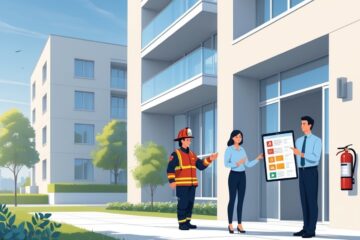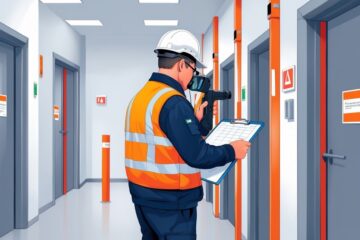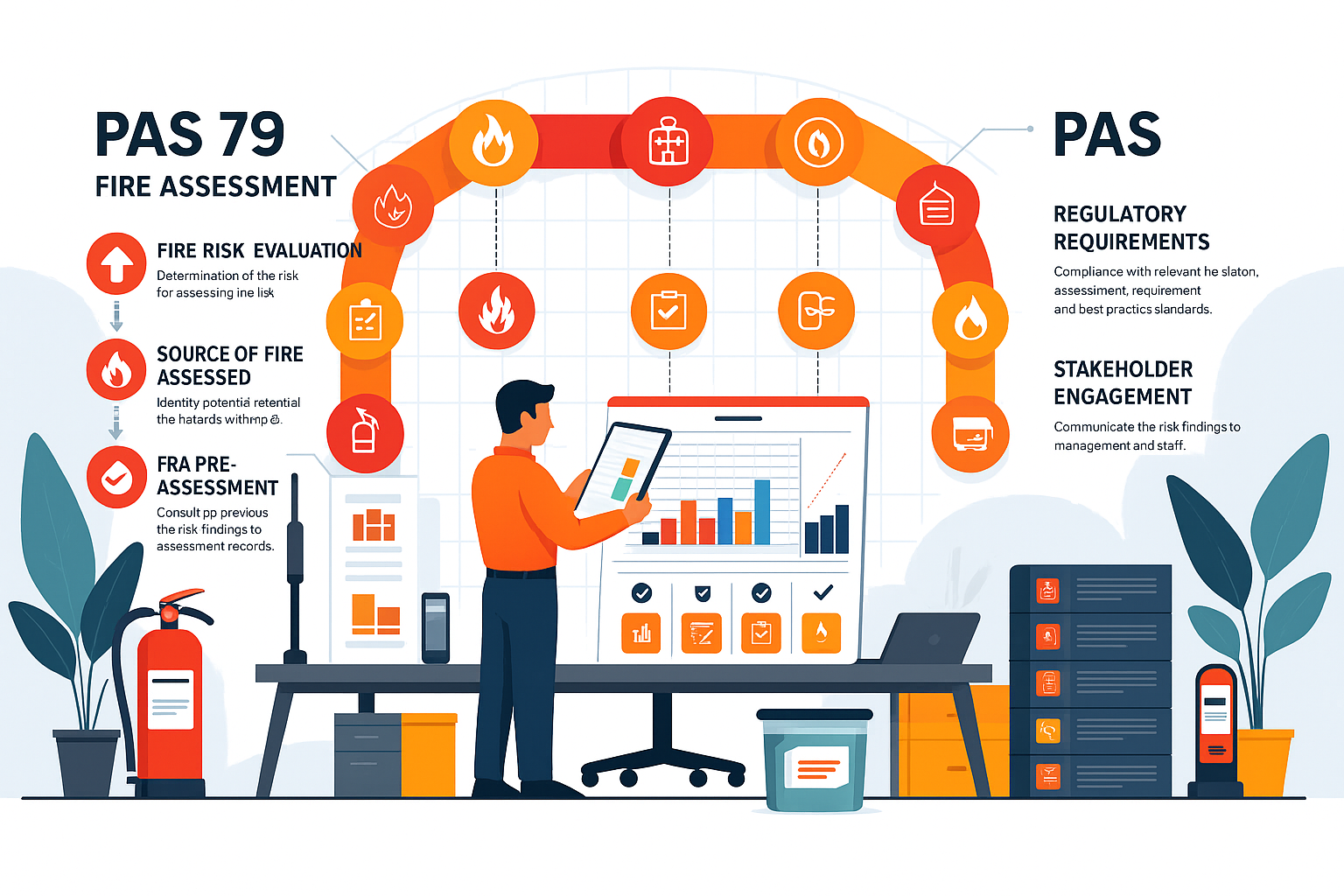Staying on the right side of the Regulatory Reform (Fire Safety) Order and the new Building Safety Act has never mattered more: one lapse can close a building overnight and land you with six-figure fines. This Complete 2025 Fire Risk Assessment Guide for UK Building Owners cuts through the jargon and shows, step by step, how to keep every office, warehouse or residential block both safe for occupants and fully compliant for insurers, regulators and investors.
We’ll break down the latest legal duties, reveal the common fails that trigger enforcement notices, and map out a practical action plan—from site survey to digital compliance pack—so you can prove due diligence and protect your asset value. Whether you manage a single high-rise or a national portfolio, this guide delivers the clear, up-to-date answers you need to sleep at night.
Before we start, if you want to book a professional fire risk assessment, get in touch today! We’re here to help.
Fire Assessment At-a-Glance
| If this is true… | …then do this | Why? |
|---|---|---|
| Your last recorded fire risk assessment (FRA) is >12 months old | Book a new assessment now | Article 9 of the Fire Safety Order says assessments must be “reviewed regularly” |
| You’ve changed the layout, processes or occupancy | Trigger an immediate review | “Material alterations” invalidate the previous assessment |
| Post-Grenfell your building is ≥11 m or ≥4 storeys | Ensure the assessor is BSR-competent and can sign high-risk buildings | The Building Safety Regulator (BSR) has new competence classes |
| You rely on a generic template you filled in yourself | Replace with a “suitable & sufficient” professional assessment | Courts have ruled templates alone rarely meet the standard |
Bottom line: Staying compliant is not a tick-box exercise; it is the only way to keep your building legally usable and safe for occupants.
Why Fire Risk Assessments Matter in 2025
Life safety comes first
- In 2024, fire services attended ~650 dwelling fires per week in England.
- A properly maintained FRA saved 28 residents in a Shepherd’s Bush flat blaze when verified escape routes worked as modelled.
Legal compliance
- Regulatory Reform (Fire Safety) Order 2005 (FSO) – still the primary law.
- Fire Safety Act 2021 – extended the FSO to façade and flat-entry doors.
- Building Safety Act 2022 – created the BSR and 30-year liability.
- Breach penalties: unlimited fines, prison, or prohibition notices that shut the building overnight.
Insurance & asset value
- UK underwriters now load premiums by 15-25 % for lapsed or DIY FRAs.
- Institutional investors treat a missing FRA as an impairment on a sale.
Reputation & ESG
- Post-Grenfell public scrutiny means a single enforcement notice can tank leasing rates.
- Occupants increasingly request evidence of safety compliance during lease negotiations.
Key Changes in 2025
| Date | Change | Impact |
|---|---|---|
| Jan 2025 | BSR competence classes (1-4) go live | Assessors signing higher-risk buildings must evidence Class 4 competence |
| Apr 2025 | HRB levy starts for buildings ≥11 m | Cost incentive to keep risks low and avoid higher levy bands |
| May 2025 | Supreme Court confirms 30-year defect liability | Historic poor FRA evidence becomes costly in litigation |
| Oct 2025 | BSR digital “golden thread” portal mandatory for HRBs | Only digitally stored FRAs accepted |
In Summary
- The government tightened who can perform and sign off FRAs.
- Failure to maintain a live, digital assessment can remove your licence to occupy an HRB.
- Liability now reaches three decades, so today’s shortcuts are tomorrow’s lawsuits.
What Counts as “Suitable & Sufficient”?
The legal test
- Article 9(1) of the FSO requires the Responsible Person (RP) to make a “suitable and sufficient” assessment of fire risk.
- UK case law shows courts look for depth, evidence and an action trail—not a one-page tick sheet.
Five mandatory pillars
| Pillar | Essential evidence |
|---|---|
| Ignition sources | Hotworks permit logs, PAT tests, photos of heaters, overloaded sockets |
| Fuel loads | Quantified combustible storage, furniture inventories, waste-removal cycles |
| People & process | Day and night occupancy maps, vulnerable persons register |
| Detection & warning | BS 5839 inspection certificates, sound-pressure logs |
| Escape & mitigation | Timed egress routes, BS 5266 lighting test records, fire-door survey |
Tip: PAS 79-2:2020 is the benchmark methodology courts recognise. Ask your assessor to reference it explicitly.
Who Is the “Responsible Person”?
| Building scenario | Responsible Person (RP) | Frequent blind spot |
|---|---|---|
| Single-tenant office | Employer (the tenant) | Assuming landlord covers it |
| Multi-let office | Assuming the landlord covers it | No agreement on risers means gaps |
| Residential block managed by agent | Landlord for common parts plus each tenant for the demise | Agents think they are RP (they’re not) |
| Hotel | Operator (as employer) | Franchise misunderstanding between brand & franchisee |
Action: If your lease or management agreement muddles the RP role, issue an addendum now—BSR audits ask for evidence of clarity.
How Often Should You Review?
- Fixed intervals:
- Sleeping accommodation or HRB – every 12 months minimum.
- Offices & shops – every 24 months if no changes.
- Change triggers:
- Works that alter walls, doors, and compartment lines.
- New processes (e.g., lithium-battery storage).
- Occupancy increase >20 %.
- Best-practice calendar:
- January – book FRA review.
- April & October – six-monthly alarm inspections.
- May – annual emergency-lighting 3-hour discharge.
- December – board review of open action items.
Step-by-Step Process to a 2025-Ready FRA
Site Survey – Hazard & Escape Mapping
- Walk-through of every room, roof space and plant room.
- Data captured:
- Photo + geotag for each hazard.
- Fuel-load estimates in kg or m³.
- Measured escape-route widths and travel times.
- Digital tablets upload findings directly to the cloud—no lost notes.
Fire-Alarm Inspection (BS 5839)
- Detector tests: magnet or smoke pole triggers every head.
- Panel integrity: terminal torque check, software fault log, and PSU voltage.
- Sound-pressure tests: >65 dB general areas, >75 dB bedrooms.
- Battery change: on-site swap if capacity <80 %.
Emergency-Lighting Test (BS 5266)
- Three-hour discharge: proves battery endurance.
- Lux sampling: ≥1 lux along escape routes.
- Log-book update: immediate, while the engineer is on-site.
Risk Evaluation & Action Plan
- RAG matrix—likelihood vs. harm.
- Cost-class bands: <£250, £250–£999, £1,000+.
- Deadline column: 7 days / 30 days / 90 days.
- Assign each task to a named person; responsibility is trackable.
Digital Compliance Pack
| Component | Why it matters |
|---|---|
| PDF report | Easier to share with insurers & BSR |
| CAD overlays | Visual proof of routes and alarm zones |
| Cloud archive | Meets upcoming BSR “golden thread” requirement |
| Maintenance templates | Keeps weekly & monthly tests consistent |
Money-saving tip: Combine steps 6.2–6.4 in one visit—cuts engineer call-outs by ~30 %.
Competence & Qualifications Checklist
| Role | Personal qualification | Company badge |
|---|---|---|
| Lead FRA assessor | Level 4 Diploma in Fire Risk Assessment and BSR Class 4 | BAFE SP205 |
| Alarm engineer | FIA AO Level 2 + ECS card | BAFE SP203-1 or NICEIC Fire |
| Lighting engineer | BS 5266 CPD + LIF certificate | BAFE SP203-4 |
| Water hygiene assessor (for combined service) | City & Guilds Legionella Risk | LCA membership |
Always request:
- Insurance cover – £5 m Professional Indemnity.
- CPD record – 20 hrs+/yr.
- Sample report – look for depth, not boilerplate.
Typical Costs & ROI (London 2025)
| Building size & type | Average 2025 price (London) | Key cost drivers |
|---|---|---|
| <1,000 m² office | £450–£650 | Out-of-hours survey, CAD updates |
| 1,000–5,000 m² office | £650–£1,500 | Alarm zones >12, multiple risers |
| 10-storey office HRB | £2,000–£4,500 | BSR competency, resident liaison |
| 80-unit resi block | £1,100–£2,000 | Fire-door count, lift refuges |
Return on investment
- Insurance rebate: A-grade FRA can cut premiums 10-20 %.
- Downtime avoidance: One warehouse fire costs on average £650k in business interruption.
- Lease retention: Blue-chip tenants increasingly demand up-to-date FRA certificates at heads of terms.
Case Study: 8-Storey Office, Canary Wharf
| Metric | Before (2023) | After (2024) |
|---|---|---|
| FRA risk score (1–25) | 16 (High) | 6 (Low) |
| Insurance premium | £148k | £121k (-18 %) |
| Open actions | 42 | 0 |
| Evac-time compliance | 7:45 min | 5:10 min |
Key works: Upgraded alarm to L1, installed ADB-compliant fire doors, cleared 14 tons of combustible storage.
Payback: 14 months in premium savings alone.
7 Common Mistakes to Avoid
- Copy-paste templates – Courts dismiss them as unsuitable.
- No action tracking – An FRA without closed tasks is worthless.
- Skipping escape-route timing – The stopwatch proves compliance.
- Ignoring façade materials – Required since Fire Safety Act 2021.
- Letting the FRA lapse – >3 yrs old = non-compliant.
- Mislabelled alarm zones – Causes false evacuation and regulator fines.
- Poor record storage – Paper files won’t satisfy the 2025 digital thread.
Choosing a Competent Fire Risk Assessor
7-Question RFP Checklist
- What personal qualifications and BSR class do you hold?
- How many similar buildings have you assessed in the last 12 months?
- Can you provide a redacted sample report?
- Are you BAFE SP205 certified?
- What PI insurance limit do you carry?
- Do you include alarm & lighting tests in the same visit?
- How quickly will I receive the digital compliance pack? (Target: 48 hrs)
Post-Assessment Action Checklist
- Within 7 days
- Fix any red hazards (blocked exits, missing breakers).
- Within 30 days
- Schedule moderate works (fire-door repairs, signage).
- Within 90 days
- Budget for capital upgrades (compartmentation, L1 alarm).
- Ongoing
- Weekly alarm bell test.
- Monthly emergency-lighting flick test.
- Quarterly door-closer check.
- Log all in the downloadable template (link).
Pro-tip: Load tasks into your CAFM or even Google Calendar with reminders—evidence of proactive management impresses inspectors.
FAQ
Do I need an FRA if I employ fewer than five people?
Yes—but you may skip the written record unless the building is licensed, an HRB, or your insurer demands it. That said, written evidence is always safer.
Can I do my own FRA?
Legally, yes, if you are “competent”. In practice, courts interpret competence narrowly—most landlords outsource to protect liability.
How long is an FRA valid?
There is no expiry date in law, but regulators expect annual review (sleeping) or a two-year (office) as a minimum. Any change triggers an immediate review.
Does an FRA include sprinkler testing?
No—sprinklers fall under separate BS EN 12845 servicing. Your assessor should note their presence and maintenance status, but not test them.
What happens if I ignore the action plan?
The FRA is evidence against you: prosecution has an easier case because you knew the risks and failed to act.
Conclusion
Keeping compliant is keeping your building safe for use and occupancy. A 2025-ready fire risk assessment is more than a regulatory hurdle—it is a live management tool that:
- Protects lives and business continuity.
- Cuts insurance premiums and unlocks financing.
- Shields you from 30-year liability claims.


